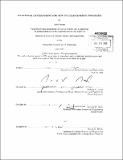| dc.contributor.advisor | Richard K. Lester. | en_US |
| dc.contributor.author | Verma, Aditi | en_US |
| dc.contributor.other | Massachusetts Institute of Technology. Dept. of Nuclear Science and Engineering. | en_US |
| dc.date.accessioned | 2013-02-14T15:31:59Z | |
| dc.date.available | 2013-02-14T15:31:59Z | |
| dc.date.copyright | 2012 | en_US |
| dc.date.issued | 2012 | en_US |
| dc.identifier.uri | http://hdl.handle.net/1721.1/76956 | |
| dc.description | Thesis (S.B.)--Massachusetts Institute of Technology, Dept. of Nuclear Science and Engineering, 2012. | en_US |
| dc.description | Cataloged from PDF version of thesis. | en_US |
| dc.description | Includes bibliographical references (p. 103-107). | en_US |
| dc.description.abstract | In the spring of 2012, nine countries were seriously considering embarking on nuclear energy programs, either having signed contracts with reactor vendors or having made investments for the development of infrastructure for nuclear energy. Several more countries are expected to initiate nuclear energy programs during this decade. The new nuclear power plants that will be built in these countries will require well-trained personnel in numbers sufficient to ensure their safe and efficient operation, maintenance and regulation. The approaches to manpower development of the American, French, Japanese, Korean, Chinese and Indian nuclear industries are described and analyzed. Lead times for the development of education and training infrastructure and for training workers are found to be of the order of several years. This necessitates forecasting manpower requirements and planning ahead. Differences between these countries in their approaches to manpower development are observed. These include differences of job specialization, educational qualifications, and workforce size. Such differences are driven by differences in the structure of the industry, regulatory pressures, historical factors and future expectations. Comparisons are also made between the nuclear, coal, and airline industries in the U.S. These findings have important implications for the institutional design of new nuclear energy programs. Differences in the objectives, expected scale, and pace of development of these programs mean that systems of manpower development need to be tailored to each country. A hierarchy of strategic and implementational decisions informing the creation of manpower development systems for newcomer countries is presented. | en_US |
| dc.description.statementofresponsibility | by Aditi Verma. | en_US |
| dc.format.extent | 107 p. | en_US |
| dc.language.iso | eng | en_US |
| dc.publisher | Massachusetts Institute of Technology | en_US |
| dc.rights | M.I.T. theses are protected by
copyright. They may be viewed from this source for any purpose, but
reproduction or distribution in any format is prohibited without written
permission. See provided URL for inquiries about permission. | en_US |
| dc.rights.uri | http://dspace.mit.edu/handle/1721.1/7582 | en_US |
| dc.subject | Nuclear Science and Engineering. | en_US |
| dc.title | Manpower development for new nuclear energy programs | en_US |
| dc.type | Thesis | en_US |
| dc.description.degree | S.B. | en_US |
| dc.contributor.department | Massachusetts Institute of Technology. Department of Nuclear Science and Engineering | |
| dc.identifier.oclc | 824624421 | en_US |
